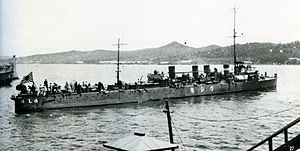Kamikaze-class destroyer (1905)

Japanese destroyer Ushio at Vladivostok 1920
|
|
| Class overview | |
|---|---|
| Name: | Kamikaze class |
| Operators: |
|
| Preceded by: | Harusame class |
| Succeeded by: | Umikaze class |
| In commission: | 16 August 1905 - 1 April 1928 |
| Completed: | 32 |
| Lost: | 2 |
| Retired: | 30 |
| General characteristics | |
| Type: | Destroyer |
| Displacement: |
|
| Length: |
|
| Beam: | 6.57 m (21.6 ft) |
| Draught: | 1.8 m (5.9 ft) |
| Propulsion: | 2-shaft reciprocating, 4 coal-fired boilers, 6,000 ihp (4,500 kW) |
| Speed: | 29 knots (54 km/h) |
| Range: | 850 nmi (1,570 km) at 11 kn (20 km/h) |
| Complement: | 70 |
| Armament: |
|
The Kamikaze-class destroyers (神風型駆逐艦 Kamikaze-gata kuchikukan?)(""divine wind"") were a class of 32 torpedo boat destroyers (TBDs) of the Imperial Japanese Navy. The Kamikaze class of destroyers were the first destroyers to be mass-produced in Japan. The class is also sometimes referred to as the Asakaze class. This class of destroyer should not be confused with the later Kamikaze-class destroyers built in 1922, which participated in the Pacific War.
The Kamikaze-class destroyers were part of the 1904 Imperial Japanese Navy Emergency Expansion Program created by the outbreak of the Russo-Japanese War. Twenty-five vessels were ordered, and an additional four vessels were ordered in 1905, and three more in 1906, bringing the total to thirty-two ships. The Japanese governmental shipyards were overwhelmed with the volume of construction, and for the first time civilian shipyards were also assigned to produce warships.
In terms of design, the Kamikaze-class ships were substantially identical to the previous Harusame class, in terms of hull design and external appearance, retaining the flush deck design with a distinctive "turtleback" forecastle inherited from the Ikazuchi class, as well as the four-smokestack profile. However, with operational experience gained in the Russo-Japanese War, the Kamikaze class employed shorter smokestacks with spark and glow arrestors to give the ships a more stealthy capability for night combat operations.
...
Wikipedia
